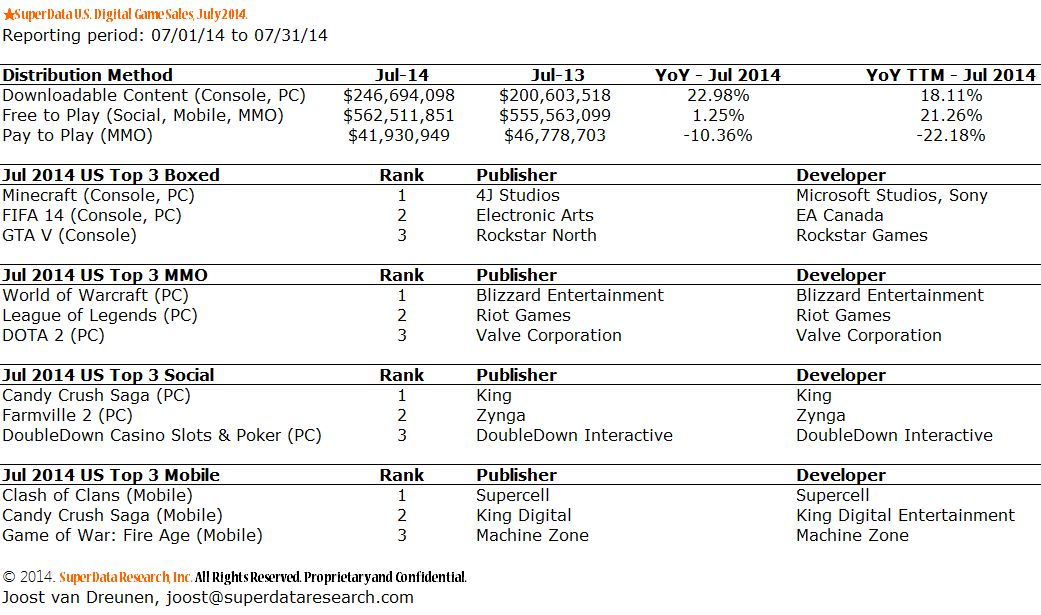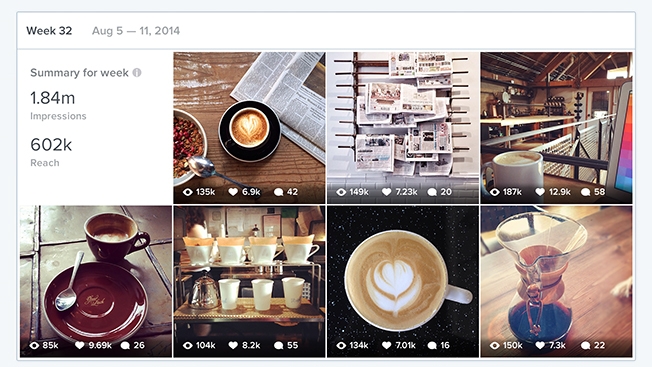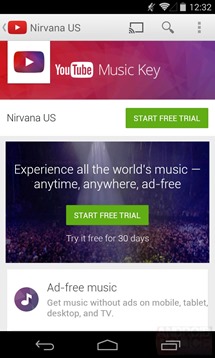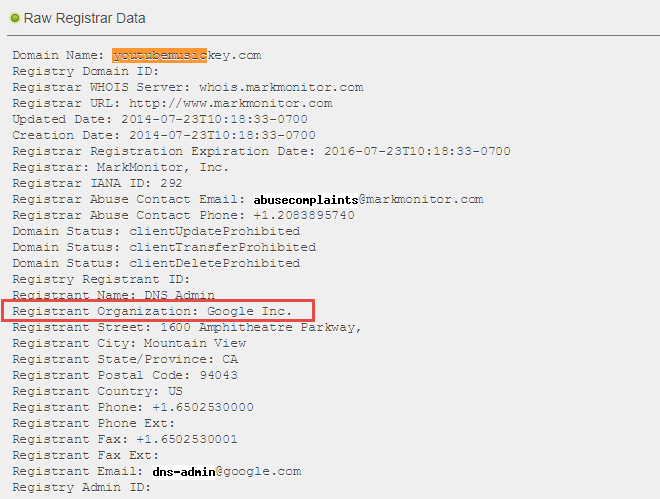Analysis from SuperData CEO, Joost van Dreunen, follows:
Overall digital games sales reach $851 million in July, up six percent compared to the same month last year. As the market ramps up for the holiday season, we anticipate a further drop in August after which spending will climb to an estimated $1.2 billion in December.
Despite a pickup in the social and mobile categories, good for a combined $442 million in spending (July 2014), the strain among major publishers to maintain earlier growth levels is starting to show. Because of a lack of new title releases, Grand Theft Auto V managed to wiggle its way back into the number three slot of top downloaded digital titles, following FIFA 14 and with Minecraft at the top of the charts.
Major publishers’ transition to digital in full swing
Several of the major Western publishers released their quarterly figures, showing an increased reliance on digital channels. Electronic Arts benefited from the worldwide attention for soccer as FIFA Ultimate Team drove the success of its digital category. It also provided an answer to the question of whether digital distribution improves margins by posting a record-breaking 70 percent gross margin for the quarter. In addition, the company reported a growth in full game downloads, as EA’s digital revenue for the quarter reached $482 million.
Competitors Activision and Take-Two Interactive also posted higher than expected digital revenues, indicating that the major publishing houses in the West are well on their way toward a predominantly digital publishing model. Digital laggard Ubisoft posted $112 million in digital revenues, largely because of the success of Watch Dogs. Nonetheless, the publisher has still some work to do if it’s going to catch up on its peers.
Have a go at the buffet while you wait for 2015, says EA
Perhaps in an attempt to placate gamer sentiment, Electronic Arts announced its plans to offer several of its staple titles via its EA Access subscription plan on Xbox One. Despite the euphoria of reporting higher than expected revenue in its most recent quarterly earnings statement, the company postponed several key titles. Arguing that it wanted to further polish its games and incorporate feedback it had received during E3, Dragon Age: Inquisition was moved to November this year and Battlefield Hardline to March, 2015. Moreover, several of its key franchises suffered from a poor launch (NBA Live 14, Battlefield 4) and the absence of NCAA Football 15 depressed overall sales in the US.
EA Access is likely to attract a subset of core players, but is unlikely to get traction with a larger audience as gamers are increasingly hesitant to commit to monthly payments. Finally, given Sony’s reservation with regards the value of the EA Access proposition, it raises the question of whether EA can successfully offset a delay in title releases with incremental subscription revenue.

Player 3 enters the game: Can Smite become the third most popular MOBA eSports title
With a prize pool of $600,000 for its upcoming world championship, the mythology-inspired Smite is quickly becoming one of the more popular MOBA titles for competitive gaming. Its traction with gamer audiences raises the question as to what the future of MOBA eSports will look like: will competitive gaming settle around a single game like League of Legends, or will it allow for several titles within the same category, each with slightly different game mechanics and rulesets For now, it appears there is enough appetite out there to sustain a fragmented market around a myriad of games.
The MOBA category is still growing, with category leader League of Legends growing to 78 million monthly actives last month. Smite currently hovers around one million monthly actives since its launch in March earlier this year, and still has some ways to go. But it took DOTA 2 only about a year and a half to get from 1.5 monthly actives to 9 million (July 2014). In the long term, the interests of advertisers may force eSports to consolidate and reduce the friction of a fragmented audience. But with a few exceptions, advertisers have been slow to capitalize on competitive gaming.
Social and mobile gaming increasingly resemble traditional publishing
Zynga announced several delays in order “to improve product quality and customer experience.” Such a statement is common in the console market, but for a social game publisher to push back a release date is odd: social games are continuously updated and optimized post-launch. The decision suggests that social gaming is starting to resemble traditional publishing. As the social games market reaches saturation, companies increasingly rely on the effectiveness of their initial marketing push to establish market share and a sustainable user base. In addition, marketing expenses continue to grow: the CPI for social games in the US reached $2.25 (June 2014), the highest it’s been in over a year.
King’s situation proved no better. Following a successful start for Farm Hero Saga, which reached a peak of 30 million monthly actives on social (May 2014), the game’s player base has started to erode at a rate of approximately 4 percent in the last two months, dropping to 28.1 million actives in July. In tandem, Candy Crush Saga on Facebook dipped under $20 million in monthly earnings.
Some thoughts from SuperData’s CEO on the July report:
[a]listdaily: How is World of Warcraft holding the #1 slot against League of Legends and DOTA 2 How big a boost is Warlords of Draenor going to give World of Warcraft, and how long will it last?
Joost van Dreunen: World of Warcraft lives in a different category, both from a game mechanical and monetization perspective. Its strength lies in its loyal user base, which by now consists mostly of veteran players who like to hang out together. There’s no comparable socializing on League of Legends or DOTA 2, as these games cater to a different gamer type. New content releases always do wonders for World of Warcraft, but at this point in its lifecycle we’re expecting it to be lower and shorter than the previous ones.
[a]listdaily: There’s been speculation about possible subscription plans for regular content drops, perhaps for titles like Destiny. Do you think that will be tried, or is a monthly subscription just going to disappear all around?
Joost van Dreunen: I have no doubt that publishers will try different subscription-based offerings: from a financial standpoint it makes sense, and it helps qualify dedicated gamers. However, we are still a long way from game publishers adopting a similar model as premium TV networks, even though I do think that’s a feasible strategy.
[a]listdaily: Candy Crush Saga is losing some steam — will it start to drop in the rankings Is Clash of Clans holding steady or improving, or is it, too beginning to decline Do you see turnover in the mobile Top Ten increasing, diminishing, or staying the same over the next six months
Joost van Dreunen: Titles like Candy Crush Saga and Clash of Clans will decline at a slow pace. Unlike the short-lived success of mobile titles like Flappy Bird, these blockbuster hits will continue to claim both time and wallet share, giving King and Supercell time to come up with the next title. Over the next six months we’re expecting to see turnover in bottom half of the top ten, especially toward the holiday season.
www.superdataresearch.com
 A look at Instagram’s new brand insights dashboard.
A look at Instagram’s new brand insights dashboard.



 Shuhei Yoshida
Shuhei Yoshida
